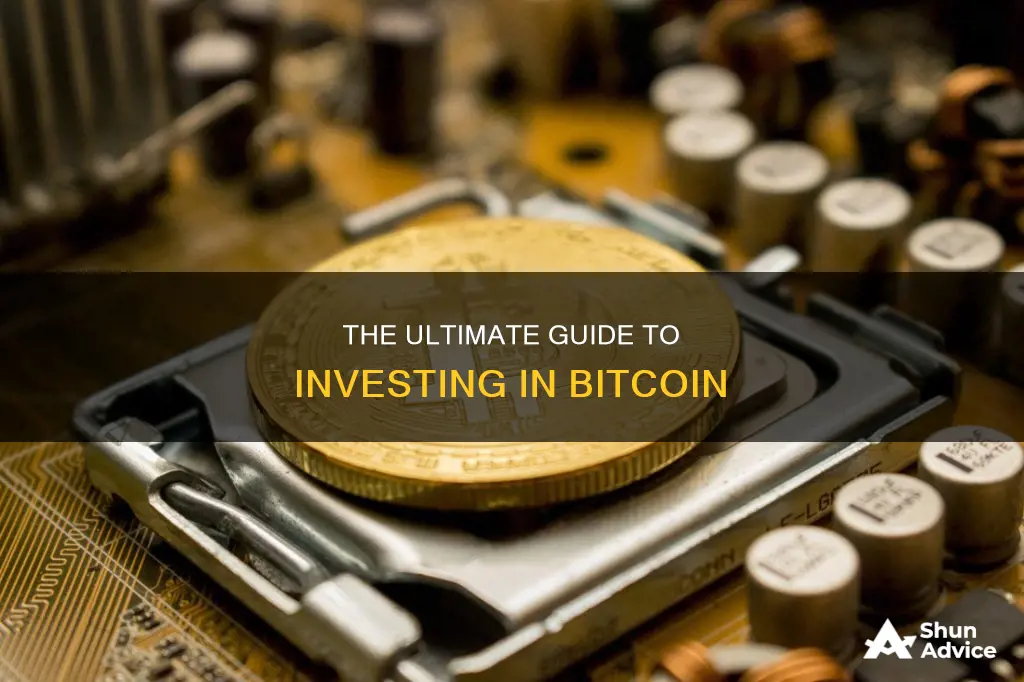
Bitcoin is one of the most widely used types of cryptocurrency. It was created to solve a couple of big cryptocurrency flaws: firstly, to prevent crypto coins from being fraudulently duplicated, and secondly, to stop people from reproducing crypto coins. Bitcoin uses a digital technology called blockchain, which disperses a single code over thousands of different computers.
If you want to invest in Bitcoin, you'll need to join a Bitcoin exchange, get a Bitcoin wallet, connect your wallet to a bank account, place your Bitcoin order, and manage your Bitcoin investments.
There are several different ways to invest in Bitcoin, both directly and indirectly. You can invest in a company that utilizes Bitcoin technology, or participate in Bitcoin mining.
| Characteristics | Values |
|---|---|
| Creator | Satoshi Nakamoto |
| Year of Creation | 2009 |
| Purpose | To prevent crypto coins from being fraudulently duplicated |
| Technology Used | Blockchain |
| Wallet Types | Hot wallet, Cold wallet |
| Examples of Hot Wallets | Electrum, Mycelium |
| Examples of Cold Wallets | Ledger, Trezor |
| Examples of Crypto Exchanges | Coinbase, Binance, Kraken, Gemini, Bitfinex |
What You'll Learn

Choosing a Bitcoin exchange
- Goals: First, know what you are looking to accomplish. For example, is the goal to simply invest on a longer-term basis, or to trade in and out of positions regularly?
- Regulations and security: Different exchanges comply with different laws and regulations, based on their locations, practices, and offerings. Some exchanges have Know Your Customer (KYC) and Anti-Money Laundering (AML) practices, requiring participants to submit personal information. Many crypto exchanges ban customers residing in certain countries.
- Reputation: The cryptocurrency space is still largely a new industry, so it is important to be aware of the reputation of each exchange. Many exchanges have been involved in nefarious activities, hacks and exit scams. It is important to conduct research on different exchanges, searching them on Google alongside the term “scam” and evaluating the results.
- Security: Each exchange has its own chosen security methods. Check to see if the exchange offers two-factor authentication (2FA). Google authenticator, Authy and Yubikey are three common avenues for 2FA as they arguably offer better security than mobile text-based 2FA.
- Fiat compatibility: At some point, you will likely require a fiat-compatible exchange, allowing you to transfer national currencies (USD, CAD, etc.) into the crypto world for trading use, and out of the crypto world to cash out profits. Some exchanges have different fiat options, compatible with specific banks, and some do not.
- Trading options: Derivatives exchanges frequently offer leverage trading, allowing traders to borrow a certain amount of funds for trades. Multiple exchanges offer anywhere from 1x to 100x leverage.
- Volume: Trading platforms vary based on the number of participants using them at any given time, as well as the amount of each asset being traded. If a trader is looking to sell 100 BTC, they will likely not be able to do so on a low-volume exchange as not enough sellers may exist at the current listed market price.
- Price: Asset prices also vary across multiple exchanges. Crypto assets might trade higher or lower on one exchange versus another due to participant location, volume and other factors. Noting these discrepancies can factor into choosing an exchange, especially when altcoins are concerned.
- Coins and tokens: Top digital assets such as Bitcoin, Ethereum (ETH) and Litecoin (LTC) are widely available on most crypto exchanges. Other smaller-cap coins and tokens, however, may not be available on certain exchanges.
- Fees: Most exchanges charge a small fee for each trade. These fees vary based on the platform, and are usually based on a percentage of each trade. Some exchanges also have withdrawal fees and limits.
- User interface and experience: This criterion is very important to your success as a cryptocurrency trader or investor. An exchange with an intuitive interface and good user experience makes it easier to trade the cryptocurrencies available. However, user experience is subjective, and people enjoy various interfaces.
Best Bitcoin Investment Options: Current Market
You may want to see also

Getting a Bitcoin wallet
Once you've decided to invest in Bitcoin, you'll need to get a Bitcoin wallet to store your crypto. There are several types of Bitcoin wallets, including hosted wallets, non-custodial wallets, and hardware wallets.
Hosted Wallets
Hosted wallets are the most popular and easy-to-set-up type of crypto wallet. When you buy crypto using an app like Coinbase, your crypto is automatically held in a hosted wallet. This is called a hosted wallet because a third party, like a bank, keeps your crypto for you. The main benefit of a hosted wallet is that if you forget your password, you won't lose your crypto. However, a drawback is that hosted wallets don't currently allow access to all crypto features.
Non-Custodial Wallets
A self-custody or non-custodial wallet, like Coinbase Wallet, puts you in complete control of your crypto. Non-custodial wallets don't rely on a third party to keep your crypto safe. While they provide the software to store your crypto, the responsibility of remembering and safeguarding your password, also known as a private key or seed phrase, falls entirely on you. If you lose or forget your password, there's no way to access your crypto. Non-custodial wallets also allow you to access more advanced crypto activities like yield farming, staking, lending, and borrowing.
Hardware Wallets
A hardware wallet is a physical device, about the size of a thumb drive, that stores the private keys to your crypto offline. Most people don't use hardware wallets because of their increased complexity and cost. However, they can keep your crypto secure even if your computer is hacked. This advanced security makes them less user-friendly than software wallets, and they can cost upwards of $100 to buy.
Setting Up Your Wallet
Regardless of the type of wallet you choose, you'll need to do some research and select a platform or app that you trust. Security, ease of use, and compliance with government and financial regulations should be your main considerations. Once you've chosen a platform, you'll need to create an account, using a secure password and, ideally, two-step verification. Then, you can buy or transfer crypto to your new wallet.
The Lightning Network: Bitcoin's Future and How to Invest
You may want to see also

Connecting your wallet to a bank account
Step 1: Access the "Add Account" Screen
On the All Accounts screen, click on the Add Account box in the list of accounts. Alternatively, if you are using a mobile device, swipe left on your dashboard until you reach the end of your accounts. Swipe left once more to access the "Add Account" screen.
Step 2: Select "Bank Sync"
To add a bank-connected account, choose the Bank Sync option. This will allow you to link your bank account directly to your wallet.
Step 3: Provide Bank Information
Enter your bank's country and name in the search field. If your bank is not found, you may need to submit a request for integration.
Step 4: Select Your Banking Portal
From the drop-down field, select your banking portal. This will allow the wallet to connect to your specific bank.
Step 5: Enter Login Credentials
Enter the login credentials you normally use to access your bank's website. Depending on your bank, you may also need to answer additional security questions.
Step 6: Choose Your Account
If you have multiple accounts with the same bank, choose the specific account you want to link to your wallet.
By following these steps, you can securely connect your wallet to your bank account, facilitating seamless transactions between the two. Remember to keep your login credentials safe and secure, and be cautious when accessing your financial information on public networks or devices.
The Ultimate Guide to Bitcoin Investment
You may want to see also

Placing your Bitcoin order
Once you've chosen a cryptocurrency exchange, you'll need to establish an account and fund it with fiat money. Then, you can place a buy order for your chosen cryptocurrency.
Market Order
A market order is a direct buy order, instructing the broker to buy or sell a security immediately. This type of order has the highest priority and is executed immediately at the best available price. The main advantage is that it is executed immediately, making it suitable when speed is a priority over price. However, in volatile markets, the execution price may differ from the expected price. Market orders cannot be cancelled as they are filled immediately.
Limit Order
A limit order is an instruction to buy or sell an asset at a set price or better. This type of order offers investors more control over the price and is only executed when the market value reaches or exceeds the set limit. When buying, this means the order will only be executed at the set limit price or cheaper; when selling, it will only be executed at the limit price or higher. This allows investors to avoid unexpected costs caused by sudden price changes but may not be executed if the market price does not reach the limit.
Stop-Loss Order
A stop-loss order is an instruction to sell an asset when the price reaches or falls below a specified stop price. This type of order is designed to limit losses by ensuring a security is sold before it loses further value. A major disadvantage is that the actual selling price can be significantly lower than the set stop price in highly volatile markets.
Stop-Limit Order
A stop-limit order combines the functions of a stop order and a limit order. It is executed when the price of a security reaches a specified stop price, but only at a certain limit price or better. This type of order allows investors to precisely determine the maximum acceptable loss or profit and offers more flexibility and adaptability to different market situations. However, it is more complicated than simple market or limit orders and requires a good understanding of the underlying mechanisms.
Stop-Buy Order
A stop-buy order is used to buy an asset once the price reaches or exceeds a certain stop price. This is useful for entering a rising market. Once the stop price is reached, the stop-buy order is converted to a market order type and is immediately executed at the best available price. However, there is no guarantee that the order will be executed at the expected price.
Trailing Stop Order
A trailing stop order is a dynamic tool that automatically adjusts the stop price when the market price moves favourably. It is used to lock in profits while increasing the potential for further profits. The advantage of a trailing stop order is that it allows investors to lock in profits while maintaining the potential for further gains. However, it is extremely complex and requires a good overview of how the markets work and the correct setting of the trailing distance.
If-Done Order
An if-done order is another example of a combined order type. The second order is activated only when the first order has been fully executed. This type of order gives investors a distinct advantage by reducing the need for manual intervention and enabling more complex trading strategies. However, it requires investors to be familiar with market mechanics and place orders correctly.
One Cancels the Other (OCO) Order
An OCO order consists of two orders, a buy and a sell order. When one of the two orders is executed, the other is automatically cancelled. This type of order offers flexibility and control as the investor is prepared for both rising and falling market movements. However, it is complex and requires a good knowledge of market processes.
Next Order
A Next Order is similar to an If-Done Order but is independent of the result of the previous order. This type of order allows investors to plan and execute a sequence of transactions while reducing the need for constant market monitoring and manual intervention. However, it is highly complex, and investors should have a good understanding of market mechanisms and carefully plan the sequence and conditions of orders.
Dappradar Coin: A Good Investment or Just Hype?
You may want to see also

Managing your Bitcoin investments
- Monitor Market Trends and Regulatory News: The cryptocurrency market is highly volatile and susceptible to various global factors. Stay updated with the latest market trends and regulatory changes, as they can significantly impact your investment strategy. Being aware of these factors will help you make informed decisions and adapt to market changes.
- Choose a Reputable Platform: Select a reliable and user-friendly trading platform that offers robust security measures and has a good reputation in the crypto community. A good platform will provide you with the necessary tools to manage and track your investments effectively.
- Diversify Your Investment Strategies: Don't put all your eggs in one basket. Diversify your Bitcoin investments by adopting multiple strategies such as long-term holding (HODLing), regular buying through dollar-cost averaging (DCA), swing trading, or day trading. This will help you manage risk and maximise potential profits.
- Use a Secure Digital Wallet: Since crypto is a digital-only asset, you need a secure digital wallet to store your Bitcoin. You can choose between a hot wallet, provided by crypto exchanges or software providers, or a cold wallet, which is an offline encrypted device. Consider your security needs and preferences when selecting a wallet.
- Regularly Review and Rebalance Your Portfolio: Periodically review your entire investment portfolio to assess the need for rebalancing. Depending on your investment goals and financial needs, you may need to adjust your crypto exposure by buying more or selling some of your Bitcoin holdings.
- Consider the Risks and Rewards: Bitcoin is a volatile investment with substantial risks. Evaluate the potential risks and rewards before investing and ensure that you are comfortable with the level of risk. Don't invest more than you can afford to lose, and always do your research to make informed decisions.
- Long-Term Investment Approach: While short-term price swings can be tempting for day traders, a long-term investment strategy may be more fruitful for patient investors. Remember that Bitcoin taxes follow capital gains rules, so consider the tax implications of your investment horizon.
- Utilise Automated Tools: Take advantage of automated tools and services offered by some platforms, such as intelligent portfolio services. These tools can help you automate investment decisions, optimise returns, and effectively manage risk by diversifying your asset allocation.
- Start Small and Learn Continuously: If you're new to Bitcoin investing, start with small investments and gradually increase your exposure as you gain experience and confidence. Continuous learning and research are key to successful Bitcoin investment management.
- Emotional Discipline: Keep your emotions in check when investing in Bitcoin. Don't make impulsive decisions based on fear or greed. Stick to your investment plan and long-term strategy, and remember that Bitcoin is a long-term investment that may experience ups and downs.
By following these tips and staying informed about the market, you can effectively manage your Bitcoin investments and navigate the cryptocurrency market successfully. Remember to always do your own research, assess your risk tolerance, and make investment decisions that align with your financial goals.
Calculating Bitcoin ROI: A Step-by-Step Guide
You may want to see also
Frequently asked questions
You can buy Bitcoin through a cryptocurrency exchange such as Coinbase, Binance, Kraken, Gemini, or Bitfinex. You will need to create an account, verify your identity, and link your bank account to make a purchase.
Bitcoin is a very high-risk investment due to its volatile nature. The value of Bitcoin can rise or fall dramatically in a short period, and it is not backed by any physical asset or central regulator. There is also a risk of "pump-and-dump" schemes, where predatory investors convince amateurs to buy Bitcoin, causing a surge in prices, and then sell all their holdings before the buying surge ends, causing prices to plummet.
The main benefit of investing in Bitcoin is the potential for huge returns. If you purchase a large amount of Bitcoin and there is a market surge, you could sell your coins at a much higher value. Bitcoin is also highly liquid, so any realized gains can be accessed almost immediately.
Your Bitcoin is stored in a "wallet", either a "hot wallet" or a "cold wallet". A hot wallet is operated by your cryptocurrency exchange or provider and is convenient for accessing your coins through the internet or a software program. However, it is less secure than a cold wallet. A cold wallet is a physical piece of hardware, similar to a flash drive, that stores your coins and is a safer option for large amounts of Bitcoin.







